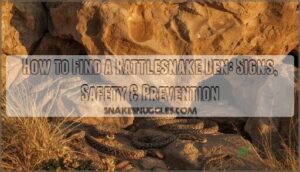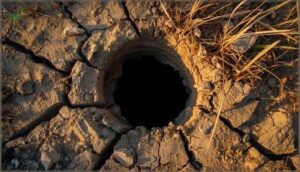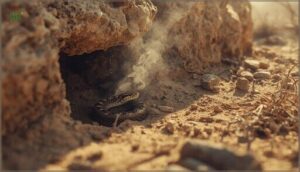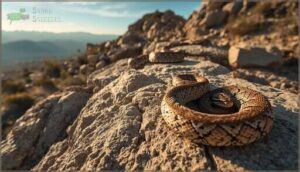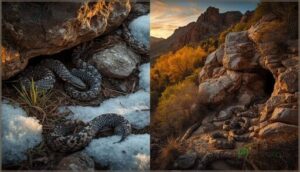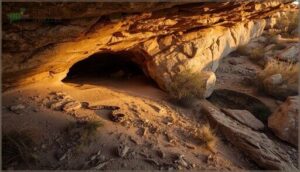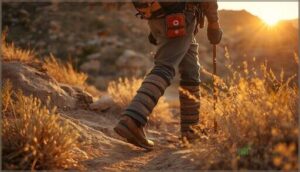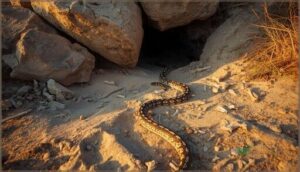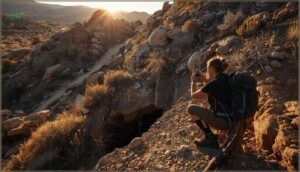This site is supported by our readers. We may earn a commission, at no cost to you, if you purchase through links.
A rattlesnake den isn’t what most people imagine—there’s no telltale sign saying “danger ahead,” no obvious warning until you’re already too close. These snakes return to the same hibernation sites year after year, sometimes for generations, and during peak seasons like spring emergence or fall congregation, a single den can shelter dozens of individuals.
That pile of rocks at the edge of your property, the abandoned burrow near your hiking trail, or the gap beneath your deck could host an active den without you ever knowing.
Learning to recognize the subtle indicators of rattlesnake dens—from shed skins and distinctive entrance holes to basking patterns and seasonal activity—gives you the knowledge to avoid dangerous encounters and coexist safely with these misunderstood predators.
Table Of Contents
- Key Takeaways
- Where Are Rattlesnake Dens Commonly Found?
- What Features Identify a Rattlesnake Den?
- When is The Best Time to Find Dens?
- How Do Rattlesnakes Choose Den Locations?
- What Safety Measures Should You Take?
- How Can You Confirm a Den is Active?
- What Should You Do After Finding a Den?
- How Can You Prevent Rattlesnake Dens Nearby?
- Frequently Asked Questions (FAQs)
- How do I find a Rattlesnake Den?
- How do rattlesnakes live?
- Do rattlesnakes dig holes?
- How many rattlesnakes are in a den?
- How far does a rattlesnake stray from a den?
- Should you remove a Rattlesnake Den?
- How far do rattlesnakes go from a den?
- Where are rattlesnake dens most common?
- When is the best time to find a Rattlesnake Den?
- Are Rattlesnake Dens Dangerous?
- Conclusion
Key Takeaways
- Rattlesnakes return to the same communal hibernation sites year after year, often on south-facing rocky slopes or in abandoned rodent burrows, with some dens sheltering 30 to 100 individuals during winter months from October through March.
- The most reliable signs of an active den include fresh shed skins near entrances, small circular holes with smooth edges, basking snakes visible during spring emergence (late March through April) or fall congregation (September through October), and distinctive drag marks in surrounding soil.
- Prevention focuses on eliminating attractions rather than blocking every gap—remove rodent populations by securing food sources, seal foundation cracks and openings larger than ¼ inch, and install snake-proof fencing with mesh no larger than ¼ inch buried 6–12 inches deep.
- If you discover a den, mark the GPS coordinates, report it to wildlife authorities for conservation tracking, and maintain at least a 10-foot distance without disturbing the site, as many rattlesnake species carry legal protections and professional removal services offer the safest relocation option.
Where Are Rattlesnake Dens Commonly Found?
Rattlesnakes don’t just settle anywhere—they’re picky about their den sites, choosing spots that offer shelter, temperature control, and easy access to prey. Understanding where these snakes usually hide can help you identify potential dens on your property or while hiking.
Let’s look at the most common locations where rattlesnakes establish their dens.
Rocky Outcroppings and Crevices
Among all rattlesnake dens, rocky outcrops offer the most reliable shelter. You’ll find communal hibernacula in these rocky areas, especially on south-facing slopes where crevice microclimates stay warmer. Rock composition matters—look for formations with deep fissures extending two to four feet underground.
Identifying rattlesnake dens means checking slope orientation and den depth, since snakes prefer sun-exposed sites with interconnected crevices that protect dozens of individuals through winter. These sites are critical for avoiding freezing temperatures.
Abandoned Rodent Burrows
Beyond rock crevices, rattlesnakes commonly occupy abandoned rodent burrows—especially prairie dog tunnels. Research on prairie rattlesnakes in Colorado shows these burrows extend below the frost line, creating stable burrow microclimates that stay above freezing during five to six months of hibernation. You’ll notice den reuse patterns where snakes return yearly to the same burrow systems.
Maintaining healthy rodent populations ironically bolsters rattlesnake habitat, since prey abundance and burrow depth determine overwinter survival in grassland areas lacking rocky outcrops. Habitat suitability models can help identify potential rattlesnake hibernacula.
Under Logs, Wood, or Rock Piles
In places without natural rock formations, rattlesnakes will den under logs, wood piles, or decorative rock landscaping. These artificial dens create stable pile microclimates when gaps between materials form interconnected voids.
Look for rock landscaping with rodent tunnels beneath—these increase communal occupancy by multiple snakes. Identifying snake dens under rocks or stacked wood near your home demands careful risk management, since these features both shelter snakes and attract prey.
Residential Structures and Foundations
Surprisingly, rattlesnakes often den right under your home. In 2021, professionals removed 92 rattlesnakes—including newborns—from beneath a single California foundation. These reptiles target crawl spaces, porches, and decks because retained rock and foundation denning voids provide stable temperatures and rodent prey.
Rattlesnakes often den beneath homes—one California foundation sheltered 92 snakes drawn by stable temperatures and rodent prey
Sealing entry points around concrete slabs, patios, and deck shelters blocks access. Any gap larger than a quarter-inch can admit juvenile snakes, making thorough inspections essential for preventing porches and crawl spaces from becoming communal rookeries.
Overgrown and Wooded Areas
Thick brush piles and wooded edges rank among the highest-density snake habitats. Radio-telemetry shows timber rattlesnakes prefer 40–70% canopy cover, where prey density peaks and thermal buffering stabilizes body temperature.
Edge habitats flanking forests serve as movement corridors, capturing 75% of small-mammal activity in some landscapes. You’re most likely to encounter dens where overgrown vegetation meets rocky outcrops near mature woodlands.
What Features Identify a Rattlesnake Den?
Spotting a rattlesnake den isn’t always straightforward, since these snakes prefer hidden, hard-to-reach places. However, certain telltale signs can help you identify potential den sites before you get too close. Here’s what to watch for when scanning an area.
Shed Skins and Snake Tracks
You’ll often spot shed skins near a den—they look like translucent paper and show muted earth-tone patterns with keeled scale texture. Fresh sheds feel supple, while old ones crumble.
Track patterns in sand or soft soil reveal regular drag marks or sidewinding loops, especially around vegetated transitions.
These signs cluster where rattlesnakes repeatedly return, giving you clear evidence of den identification without direct snake contact.
Small Circular Holes or Entrances
Den identification starts with spotting small circular holes in the ground—usually 0.5 to several inches across. These rattlesnake dens borrow rodent burrows rather than create new ones, so you won’t see excavated soil mounds. Key rattlesnake den locations include:
- Smooth-edged openings in prairie dog or ground squirrel colonies
- Rock features with dark, rounded voids at talus bases
- Foundation gaps near pipes or crawl spaces
Identifying snake presence requires observing surface evidence like subtle drag paths leading inward.
Presence of Musky Odor
You might catch a faint musky odor near active dens, but don’t count on it for identifying rattlesnakes. Rattlesnakes release defensive secretion from cloacal glands only when threatened, not continuously.
Musk detectability range remains under one meter, and odor persistence varies with wind and humidity. Olfactory limitations make scent trailing unreliable—musk composition degrades quickly outdoors.
Visual clues like shed skins confirm identifying snake presence far better than smell alone.
Basking Snakes Near Den Sites
If you spot rattlesnakes basking in the sun, you’re likely near a den site. Spring emergence brings the highest visibility—timber rattlesnakes in Massachusetts bask on ledges near dens throughout April, while Arizona species cluster near rock piles from late February through March.
Look for snakes on south-facing slopes, elevated hummocks, or sunlit openings within 500 meters of suspected den locations during morning hours when temperatures exceed 50°F.
When is The Best Time to Find Dens?
Timing matters when you’re trying to locate a rattlesnake den. Rattlesnakes follow seasonal patterns that make them easier or harder to spot depending on the time of year. Understanding these patterns helps you know when dens are most active and visible.
Spring Emergence Patterns
Spotting rattlesnakes at their dens becomes much easier in spring when they emerge from winter brumation. You’ll usually see rattlesnake activity ramping up from late March through April, though this varies by latitude—northern populations may not surface until mid-May.
Watch for basking snakes during the first warm days above 50°F, especially on sun-warmed rocks and south-facing slopes near den entrances, as mating season begins.
Fall Congregation Before Hibernation
Late summer through October is when you’ll see the most concentrated rattlesnake activity near dens. As temperatures cool, snakes funnel back from summer ranges—sometimes traveling several kilometers—to reach traditional hibernating sites.
Watch for dense aggregations on sunny slopes near den entrances during September and early October, when dozens of rattlesnakes may bask together before retreating underground for winter.
Winter Hibernation Period
Once rattlesnakes retreat underground, they’re nearly invisible. Hibernation duration stretches from mid-October through late April in most regions—up to 7.5 months at northern latitudes.
Den temperature stays just above freezing, stable enough to prevent death but cold enough to keep snakes dormant.
You won’t find communal denning activity during this period; rattlesnakes remain motionless in their hibernaculum until spring warmth triggers emergence.
Summer Dispersal and Activity
After spring’s stillness, summer migration shifts rattlesnakes away from dens—sometimes over 3 km. Daily movement peaks with rising temperature effects, heightening snake encounters. You’ll find them dispersed across habitat selection zones: open grasslands or forests. That’s when mortality risks climb:
- Road crossings increase with warmer weather
- Predation exposure rises during long-distance travel
- Human persecution peaks with heightened snake activity
- Vehicle strikes concentrate in summer months
Snake safety matters most during this active season.
How Do Rattlesnakes Choose Den Locations?
Rattlesnakes don’t pick their winter homes by accident. They’re looking for specific features that’ll keep them safe and comfortable during the coldest months.
Three key factors guide their choice: sun exposure, access to food and water, and protection from the elements.
Sun Exposure and South-facing Slopes
You’ll find most rattlesnake dens on south-facing slopes where sun exposure creates ideal thermal landscapes for overwinter survival. This slope geometry captures direct solar radiation, letting snakes bask and warm up quickly during spring emergence and winter breaks from hibernation.
While these sun-drenched locations offer perfect basking behavior opportunities, they also present predation trade-offs—snakes must balance warmth against visibility to predators.
Proximity to Prey and Water
Within foraging range of productive prey grounds, snake dens cluster where rodent activity peaks. Telemetry shows about two-thirds of snake locations sit within one meter of mammal burrows, revealing tight habitat overlap with prey animals.
You’ll also notice rattlesnake dens positioned within hundreds of meters of water sources—stream corridors and moist draws concentrate rodents, creating foraging patterns that keep snakes close to reliable prey distribution and hydration zones year-round.
Protection From Predators and Weather
Beyond food and water, den security shapes every choice rattlesnakes make. You’ll find their hibernacula embedded in landscapes offering layered defenses:
- South-facing rocky slopes buffer cold with stored solar heat and limit predator access through fracture mazes
- Deep crevices and talus provide thermal refuge while blocking larger mammals
- Shrub-covered burrow entrances reduce visual detection across open ground
- Elevated ledges and bluffs enable surveillance and rapid retreat routes
- Communal sites in bedrock outcrops share weather barriers and predator avoidance benefits across seasons
Climate adaptation and den security drive habitat selection as firmly as prey proximity.
What Safety Measures Should You Take?
Finding a rattlesnake den requires more than just curiosity—you need the right protective gear and a solid safety plan. Getting too close to an active den without precautions can put you at serious risk of a venomous bite.
Here are the essential safety measures you should take before searching for or approaching a rattlesnake den.
Wearing Snake-proof Boots and Gaiters
Your boots and gaiters are your first line of defense in rattlesnake country. Snake-proof boots made from Kevlar or heavy-duty ballistic nylon resist fangs far better than standard footwear—in fact, around 50% of venomous snake bites occur on feet and legs.
Look for boots extending above the calf, paired with reinforced gaiters for extra protection. Long pants and closed-toe shoes complete this essential protective gear setup.
Using Long-handled Tools
When investigating potential rattlesnake dens, a 1.5-meter snake hook or tong becomes your extension arm, keeping you outside the typical strike range. Always check under logs near rattlesnake dens with your tool, not your hands—professionals recommend placing tongs one-third down the body for controlled Snake Hook Design and safer rattlesnake den removal.
Tool Safety Tips emphasize that snake hooks distribute pressure better than clamping Tong Handling Techniques, reducing injury to the snake during Venomous Snake Removal.
Bringing a First Aid Kit
Your rattlesnake safety measures kit should prioritize Emergency Response over folklore “venom extractors”—the latter won’t help. Hospital antivenom is the only definitive Venom Treatment for venomous bite victims, so your Kit Essentials should focus on stabilizing injuries and organizing rapid evacuation, not attempting field cures.
Pack elastic bandages for pressure immobilization, sterile gauze for Wound Care, and a communication device to call for help.
Staying Alert and Observant
You can’t just rely on gear—situational alertness means training your eyes and ears every step. Visual scanning lets you spot camouflaged rattlesnakes before you’re within strike range, while auditory cues like rattles or rustling alert you to hidden threats.
Terrain awareness keeps you off risky surfaces near dens. Safe approach means no headphones, steady footing, and constant vigilance—especially at dawn, dusk, and near identified snake habitat.
How Can You Confirm a Den is Active?
Finding a potential den is one thing, but confirming it’s actually in use requires a bit more detective work. You’ll need to look for clear signs that rattlesnakes are actively coming and going from the site.
Here are the most reliable indicators that a den is currently occupied.
Observing Entry and Exit of Snakes
Direct observation remains your most reliable tool for confirming active rattlesnake dens. Watch for these clear signs of snake migration and exit strategies during peak activity windows:
- Spring emergence: Most snakes surface between 09:00 and 15:00, with over 70% returning to the same den entrance before sunset
- Fall ingress: Concentrated movements as snakes navigate back to hibernacula
- Repeated use: Individual rattlesnakes show strong fidelity, reliably returning to specific openings across years
This rattlesnake tracking approach confirms both den entrance locations and seasonal rattlesnake activity patterns.
Fresh Shed Skins or Tracks
When you can’t watch the den directly, look for physical clues. Fresh shed skins appear translucent and flexible, often with intact eye caps—these remain pliable for only days before drying out.
Shed Skin Analysis shows adult rattlesnakes usually shed once or twice yearly, so multiple fresh sheds signal communal use.
Snake tracks leave sinuous drag lines in sand or soil, creating distinctive body imprints near entrances that confirm recent rattlesnake activity within your suspected den site.
Audible Rattling or Movement Sounds
Sound is your most direct auditory cue for confirming rattlesnake den identification. When disturbed, snakes inside usually produce warning frequencies starting around 40 Hz that jump to 60–100 Hz as you approach, creating distinct rattle patterns you’ll hear before spotting movement.
Beyond rattlesnake rattles, listen for:
- Scraping sounds from body friction against rock surfaces
- Low rustling as multiple snakes reposition simultaneously
- Substrate vibrations through your boots at close range
- Overlapping snake noises forming a composite warning signal
- Faint movement preceding the characteristic rattle burst
These vibrational signals and sound waves help you detect active dens from several meters away, giving you that essential safety buffer to stop and reassess your approach before visual contact with rattlesnake behavior occurs.
What Should You Do After Finding a Den?
Finding a rattlesnake den is just the beginning—what you do next matters for both your safety and the snakes’ survival. Your response should balance responsible documentation with respect for these protected creatures and their habitat.
Here’s how to handle the situation properly once you’ve confirmed an active den.
Marking and Reporting The Location
Once you’ve confirmed a rattlesnake den, accurate Location Mapping helps protect both the snakes and your community. Use GPS Tracking on your phone to capture precise coordinates—at least four satellite signals improve accuracy. Many states require Den Registration through citizen-science platforms like iNaturalist or HerpMapper, where your findings aid Conservation Efforts. Follow local Reporting Guidelines by contacting wildlife authorities, who maintain databases of denning sites to guide safe land management and prevent accidental disturbance during development projects.
| Step | Action |
|---|---|
| 1. Record coordinates | Use your phone’s GPS to capture latitude and longitude at a safe distance from the entrance. |
| 2. Document details | Note the date, time, habitat type, and any visible snakes or shed skins. |
| 3. Submit to platforms | Report through iNaturalist, HerpMapper, or your state’s reptile atlas for official records. |
| 4. Contact local wildlife office | Reach out to regional agencies—they rely on public reports to map threatened populations. |
| 5. Maintain safety | Stay several feet back while gathering information; never approach or disturb the den. |
Avoiding Disturbance of The Den
Respecting what you’ve found is central to Conservation Efforts and Habitat Preservation—rattlesnake dens face enough threats without added human pressure.
Keep your distance beyond ten feet, don’t lift rocks or probe crevices, and resist the urge to revisit the site repeatedly.
Disturbance Prevention protects both Rattlesnake Behavior patterns and your safety, avoiding snake bites while supporting long-term Den Safety Measures and population stability.
Consulting Wildlife Authorities
After documenting what you’ve found, reach out to wildlife authorities or local experts who handle regulatory compliance and conservation efforts. Professional snake removal services and wildlife management teams can guide next steps while supporting public education. Contact:
- Your state fish and wildlife department for authority guidelines
- County extension offices with herpetology expertise
- Licensed wildlife experts trained in snake removal services
- University research programs tracking rattlesnake populations
- Conservation organizations working in your region
How Can You Prevent Rattlesnake Dens Nearby?
Keeping rattlesnakes away from your property isn’t about blocking every crack in nature’s armor—it’s about making your space less inviting. The goal is to eliminate the conditions that draw these snakes close in the first place.
Let’s walk through the practical steps that can reduce your chances of hosting an unwanted den.
Removing Food Sources and Rodent Habitats
When rodents thrive, rattlesnakes follow. Controlling rodent populations near your home directly reduces the prey that draws snakes. Store pet food and birdseed in rodent-proof containers, secure trash with tight lids, and clean up spilled seed beneath bird feeders. Remove brush piles, rock piles, and weedy fence rows that shelter mice and rats.
| Action | Target | Effect |
|---|---|---|
| Secure food in closed containers | Pet food, birdseed, grain | Eliminates rodent attraction |
| Remove debris and rock piles | Rodent nesting sites | Reduces shelter near home |
| Mow lawn closely around perimeter | Weedy cover for small mammals | Decreases snake hunting habitat |
Sealing Holes and Cracks Around Property
Think of your home as a fortress—but one where a gap the width of a pencil can breach your defenses. Rattlesnakes slip through openings as small as 1/4 inch, turning tiny foundation cracks and utility penetrations into welcome mats. Sealing these entry points is essential snakeproofing your yard and foundation.
- Inspect foundations, door thresholds, and garage bottoms for gaps where daylight shows through
- Use latex caulk or silicone for small cracks around pipes and wires
- Apply mortar to repair foundation cracks in concrete or brick
- Cover vents and larger holes with 1/4-inch hardware cloth
- Check and reseal annually, as weather degrades caulk and creates new openings
Installing Snake-proof Fencing
When put up, a fence becomes your last line of defense, and every detail counts. Snake fencing designed for rattlesnake exclusion relies on precise specifications—mesh size, barrier height, and installation depth work together to stop snakes from exploiting even a pencil-width gap. The table below breaks down the essentials for snakeproofing your yard:
| Component | Specification |
|---|---|
| Fence Material | Galvanized steel hardware cloth or PVC-coated mesh |
| Mesh Size | Maximum ¼-inch (6.35 mm) openings to block juveniles |
| Barrier Height | 36–42 inches above ground (58 inches for large species) |
| Installation Depth | Bury 6–12 inches below ground, backfilled and compacted |
| Gate Design | Solid lower panels or full mesh; thresholds under 6.35 mm |
Effective fencing goes beyond simply erecting a barrier. You’ll need to angle the fence outward by roughly 25 degrees to discourage climbing, maintain an 18-inch vegetation-free buffer along the exterior, and reinforce corners where retaining walls or foundations meet the mesh.
Pay special attention to gates, garage doors, and service entries—these are the weak points where snakes most often slip through. Professional installation usually involves a site assessment to identify existing snake routes, followed by continuous perimeter coverage that eliminates gaps larger than ¼ inch. Annual inspections catch soil erosion, landscaping changes, or damage that could compromise your barrier and undermine years of careful snakeproofing your yard.
Regular Property Inspections
Once you’ve secured your perimeter, inspection schedules become your early-warning system. Walk property boundaries monthly during warmer months, scanning for gaps, rodent burrows, and debris that form prime snake habitat. In high-risk zones, bump that to weekly checks.
Inspecting for snake dens means targeting foundations, sheds, and woodpiles—areas where rattlesnake den locations overlap with rodent traffic. Regular property inspection catches problems before prevention methods fail.
Frequently Asked Questions (FAQs)
How do I find a Rattlesnake Den?
You’ll spot snake habitat identification markers like fresh shed skins, circular burrow openings in south-facing rocky slopes, and basking snakes during spring emergence—signs revealing rattlesnake behavior patterns before the Industrial Revolution even touched these ancient denning grounds.
How do rattlesnakes live?
Rattlesnakes are ectothermic pit vipers that regulate body temperature behaviorally, entering winter brumation in communal dens from October through March.
These venomous snakes form stable social structures, often returning to shared hibernation sites annually.
Do rattlesnakes dig holes?
You won’t catch these critters with a shovel in hand—rattlesnakes can’t dig their own burrows. Instead, they’re squatters by nature, occupying existing rodent burrows, rock crevices, and ready-made underground dens for shelter.
How many rattlesnakes are in a den?
Most communal dens shelter 30 to 100 individuals, though some sites hold far fewer—under ten snakes—while remarkable hibernacula in Colorado have documented nearly 2,000 prairie rattlesnakes overwintering together.
How far does a rattlesnake stray from a den?
Like a tide drawn back to its shore each year, most rattlesnakes travel 3 to 5 miles from their den during summer. Males sometimes wander up to 5 miles during migration patterns.
Should you remove a Rattlesnake Den?
Removing a rattlesnake den yourself is risky and often illegal, since many species carry legal protections.
Snake removal services in Arizona and other states offer safer rattlesnake control through professional relocation.
How far do rattlesnakes go from a den?
Rattlesnake migration patterns vary by species and sex. Male timber rattlesnakes can travel up to 5 miles from their den during active months, while females usually stay within 1-3 miles of hibernation sites.
Where are rattlesnake dens most common?
Where there’s smoke, there’s fire—and where there’s rocky terrain with sun-drenched slopes, there’s rattlesnake dens.
These snakes favor hillside ecosystems, desert landscapes, forest edges with mammal burrows, and holes in the ground under rocks in rural areas.
When is the best time to find a Rattlesnake Den?
Spring and fall offer your best windows, when rattlesnakes bask near entrances during emergence or pre-hibernation congregation.
Temperature fluctuations between 50–60°F trigger denning cycles, making these seasonal patterns ideal for confirming active winter hibernation sites.
Are Rattlesnake Dens Dangerous?
Yes, especially when multiple snakes concentrate near entrances during spring and fall. Venomous pit vipers at dens pose real snake encounter risks, but human threats are low if you keep your distance and follow snake safety measures.
Conclusion
The irony is that knowing how to find a rattlesnake den makes you less likely to stumble upon one unprepared. Recognition transforms uncertainty into awareness—shed skins become warnings, rocky slopes demand respect, and seasonal patterns guide your caution.
You’re not hunting these creatures; you’re learning their language of place and time. That knowledge creates distance when it matters most, turning a potential crisis into a moment of informed choice. Respect the den, and it respects your space.
- https://www.pa.gov/content/dam/copapwp-pagov/en/fishandboat/documents/conservation/reptiles-amphibians/habitatcreationtimberrattlesnakes.pdf
- https://dec.ny.gov/nature/animals-fish-plants/timber-rattlesnake
- https://pmc.ncbi.nlm.nih.gov/articles/PMC7251723/
- https://www.placersnakeremoval.com/rattlesnake-encountes-temperature-analysis/
- https://pubmed.ncbi.nlm.nih.gov/39051715/

